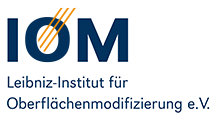K. Ueltzen, S. Schmitz, M. Moors, M. Glöß, M. Börner, I. Werner, Z. Warneke, J. Warneke, B. Abel, K. Y. Monakhov
Inorg. Chem. 2021, 60, 10415–10425
https://pubs.acs.org/doi/10.1021/acs.inorgchem.1c00994
The controlled adsorption of polynuclear coordination compounds with specific structural and electronic characteristics on surfaces is crucial for the prospective implementation of molecule–surface interfaces into practical electronic devices. From this perspective, a neutral 3d,4f-coordination cluster [MnII3MnIVYb3O3(OH)(L·SMe)3(OOCMe)9]·2MeCN·3EtOH (1·2MeCN·3EtOH), where L·SMe– is a Schiff base, has been synthesized and fully characterized and its adsorption on two different solid substrates, gold and graphite, has been studied. The mixed-valence compound with a bilayered metal core structure and the structurally exposed thioether groups exhibits a substantially different surface bonding to metallic gold and semimetallic graphite substrates. While on graphite the adsorption takes place only on distinguished attraction points with a locally increased number of potential bonding sites such as terrace edges and other surface defects, on gold the molecules were found to adsorb rather weakly on randomly distributed adsorption sites of the surface terraces. This entirely different behavior provides important information for the development of advanced surface materials that may enable well-distributed ordered molecular assemblies.
S. Schmitz, N. V. Izarova, J. van Leusen, K. Kleemann, K. Y. Monakhov, P. Kögerler
Inorg. Chem. 2021, 60, 11599–11608
https://pubs.acs.org/doi/10.1021/acs.inorgchem.1c01526
Two series of charge-neutral coordination clusters featuring quasi-isostructural metal oxide cores, isolated as [Zr6Fe2Ln2O8(ib)14(bda)2(NO3)2]·xMeCN (Ln = La (1), Ce (2), Pr (3), and Nd (4); ib– = isobutyrate; H2bda = N-butyldiethanolamine) and [Zr6Fe2Ln2O8(ib)14(mda)2(NO3)2]·xMeCN (Ln = La (5), Ce (6), Pr (7), and Nd (8); H2mda = N-methyldiethanolamine), were obtained via one-pot reactions of [Fe3O(ib)6(H2O)3]NO3 as a critical precursor, Ln(NO3)3·6H2O (Ln = La, Ce, Pr, and Nd), the respective aminoalcohol, and [Zr6O4(OH)4(ib)12(H2O)]·3Hib in an acetonitrile solution. The coordination clusters in 1–8 feature {Zr6O8} cores that are structurally expanded by two 4f (Ln3+) and two 3d (Fe3+) metal ions, each individually coordinated to one of the eight oxide centers of {Zr6O8}, producing a metal skeleton where the 3d/4f positions cap four of the triangular faces of the central Zr6 octahedron. The coordination clusters differ in the chosen aminoalcohol coligands, N-butyldiethanolamine or N-methyldiethanolamine, which lead to a different isobutyrate coordination pattern in the two series, while the {Fe2Ln2Zr6O8} core structure remains virtually unaffected. All eight coordination clusters are obtained in moderate to good yields of 29–66% after only several days. Complexes 1–8 are stable against air and moisture; they are also surprisingly thermally stable up to 280 °C in air and in nitrogen atmosphere, and they represent the first reported examples of 3d/4f-functionalized zirconium oxide clusters.
S. Schmitz, X. Qiu, M. Glöß, J. van Leusen, N. V. Izarova, M. A. Nadeem, J. Griebel, R. C. Chiechi, P. Kögerler, K. Y. Monakhov
Front. Chem. 2019, 7, 681
https://www.frontiersin.org/articles/10.3389/fchem.2019.00681/full
Two polynuclear cobalt(II,III) complexes, [Co5(N3)4(N-n-bda)4(bza·SMe)2] (1) and [Co6(N3)4(N-n-bda)2(bza·SMe)5(MeOH)4]Cl (2), where Hbza·SMe = 4-(methylthio)benzoic acid and N-n-H2bda = N-n-butyldiethanolamine, were synthesized and fully characterized by various techniques. Compound 1 exhibits an unusual, approximately C2-symmetric {CoIICoIII4} core of two isosceles Co3 triangles with perpendicularly oriented planes, sharing a central, high-spin CoII ion residing in a distorted tetrahedral coordination environment. This central CoII ion is connected to four outer, octahedrally coordinated low-spin CoIII ions via oxo bridges. Compound 2 comprises a semi-circular {CoII4CoIII2} motif of four non-interacting high-spin CoII and two low-spin CoIII centers in octahedral coordination environments. Self-assembled monolayers (SAMs) of 1 and 2 were physisorbed on template-stripped gold surfaces contacted by an eutectic gallium-indium (EGaIn) tip. The acquired current density-voltage (I-V) data revealed that the cobalt-based SAMs are more electrically robust than those of the previously reported dinuclear {CuIILnIII} complexes with Ln = Gd, Tb, Dy, or Y (Schmitz et al., 2018a). In addition, between 170 and 220°C, the neutral, mixed-valence compound 1 undergoes a redox modification, yielding a {Co5}-based coordination cluster (1-A) with five non-interacting, high-spin octahedral CoII centers as indicated by SQUID magnetometry analysis in combination with X-ray photoelectron spectroscopy and infrared spectroscopy. Solvothermal treatment of 1 results in a high-nuclearity coordination cluster, [Co10(N3)2(N-n-bda)6(bza·SMe)6] (3), containing 10 virtually non-interacting high-spin CoII centers.
